Featured Snippets are HUGE right now.
According to the latest data from Perficient, the number of featured snippets displayed within Google search results is more than doubling year-over-year.
That growth is unlikely to slow down.
What’s more, the number of zero-click searches (queries answered by a featured snippet or other search feature) has surpassed 50% of all searches on Google.
The data is clear. If you want to compete in the SERPs, now and in the future, you must learn how to get featured snippets in Google search.
The question is:
How do you optimize your content for featured snippet opportunities?
Well, that’s exactly what you’re going to learn in this featured snippet guide.
You’re about to discover everything you need to know about featured snippets from what a featured snippet is to how to get your content to appear in “position 0.” I’m covering:
- An easy-to-understand featured snippet definition
- The anatomy of a featured snippet
- Why featured snippets are critical right now (and in the future)
- Rich snippets vs Featured snippets
- Five types of featured snippets (with examples)
- How to identify featured snippet opportunities
- 15 strategies for targeting featured snippets you can implement immediately
- Includes 5 advanced featured snippet grabbing techniques
- And much more…
Let’s get started.
DOWNLOAD: A free checklist that contains all fifteen featured snippet-grabbing strategies contained in a single one-page PDF.
What is a Featured Snippet?
Featured snippets are a Google Search Engine Results Page (SERP) feature that aims to resolve a search user’s query directly from the search result.
If you’ve ever searched for something on Google and had the answer appear in a box at the top, you’ve come across a featured snippet.
For instance:
Let’s say you want to know why the sky is blue, you search “why is the sky blue” on Google, and a featured snippet is displayed:
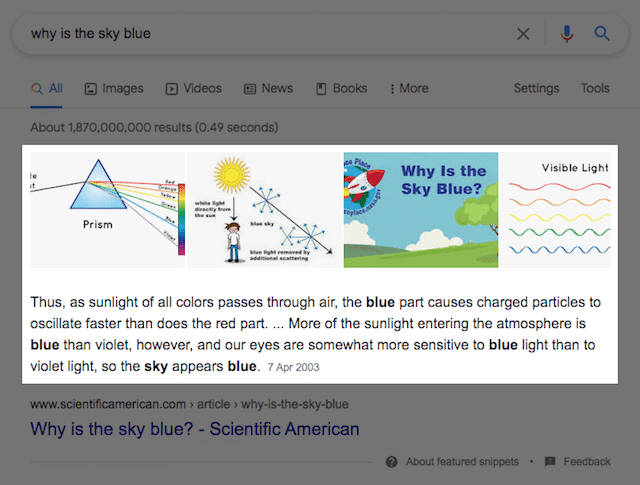
The ranking position of a featured snippet is commonly referred to as “position 0” because this snippet appears above the number one ranking link and below Google’s paid ads.
The Anatomy of a Featured Snippet
Unlike traditional search listings, which display the page’s title tag and URL above a block of text, a regular Featured Snippet displays the answer box before the clickable title and URL.

Featured snippets may also include an image alongside the text.
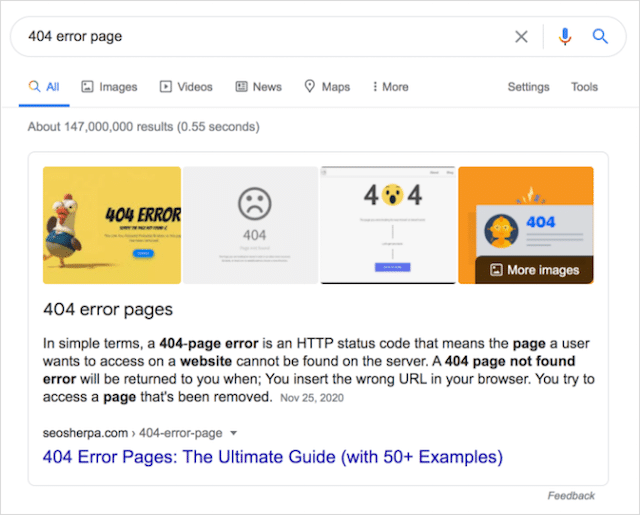
But here’s the deal:
Google determines which image (or images) to display with the featured snippet. And, those images are often pulled from pages that are not the content source.
In other words, you could get your content showing in a featured snippet, only for the accompanying image(s) to be pulled from another website.
Following along so far? Great!
Why Are Featured Snippets Important?
With Google’s algorithm choosing just one result to display as a featured snippet for a given search query…
You might be asking yourself, is it even worth trying to compete for this so-called “position 0?”
Furthermore, some SEO’s would have you believe there’s no exact formula to ranking for featured snippets.
While this may be true to a point, as I’m about to show you, improving your SEO content to match search intent will allow you to enjoy the spoils in the battle for Google’s featured snippets.
But first, let’s look at the value of featured snippets below.
The Rise of No-Click Searches (And Why Featured Snippets Are Key)
The traffic that Google sends to websites is crucial to those websites’ overall viability (yours and mine included). Any decline in organic search traffic will result in conversion and sale losses for businesses in general.
Since featured snippets were introduced to the SERPs in around 2013, Google has transformed itself from a search engine (displaying a ranked order of results) to an answer engine where answers are frequently displayed within the search engine itself.

The increase of answer boxes in search results has contributed to the shrinking of organic click-through-rates.
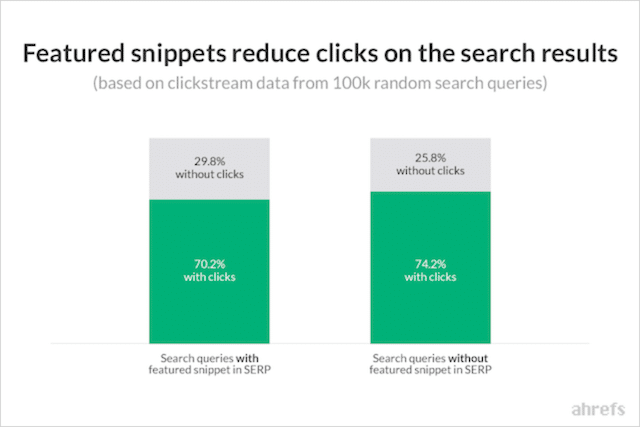
This reduction in CTR from the SERPs is most evident in mobile search results where featured snippets occupy more than 50% of the screen.
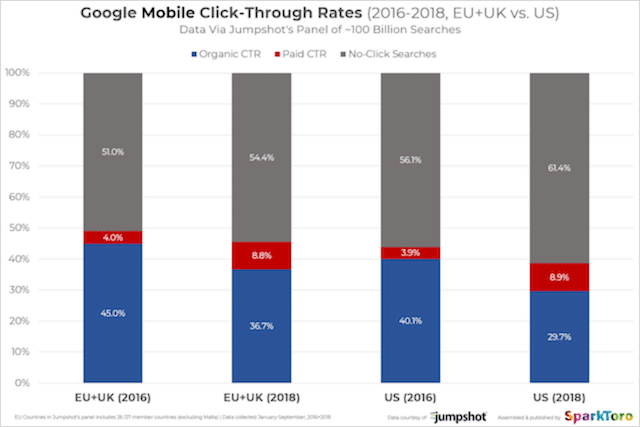
Meaning, in mobile searches where a featured snippet is displayed, regular organic results are pushed WAY below the fold.
As Google continues to siphon search traffic from brands to their own properties and in-SERP answers, brands are no longer competing against each other. They’re also competing against the search engine itself.
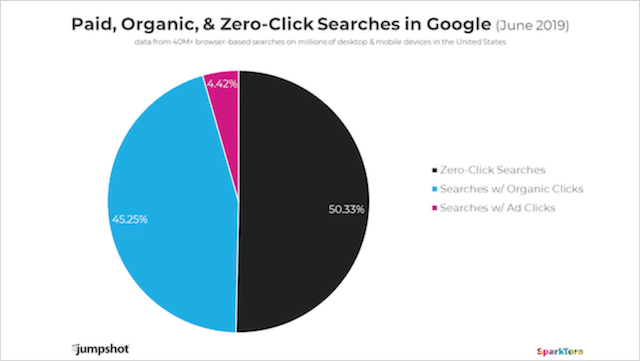
Perhaps the biggest benefit of featured snippet optimization is that it allows brands to counteract the shrinking of CTR opportunities from search.
By optimizing to appear at the top of results pages, you increase your visibility in front of potential customers. And since 9.28% of featured snippets contain commercial intent, you increase growth and conversion potential also.
This leads me to the next benefit of featured snippets.
Ranking as a Featured Snippet = More Website Traffic
Even as zero-clicks gain prominence, search users can’t help be enticed to click.
Particularly if their answer comes from a well-written and visually engaging search listing like an answer box.
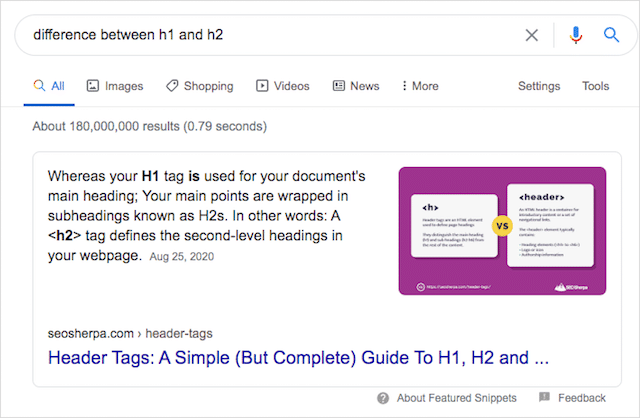
For brands who struggle to compete for position 1 in search listings, featured snippets offer a compelling way to steal clicks from the number one spot.
Let’s compare organic click-through-rates with and without a featured snippet.
As we know, data shows that position 1 has the lion’s share of clicks, 28.5% average CTR, in fact.
And this percentage precipitously drops as you go further down the ranking positions. Ranking in the SERPs’ 8th position brings in a measly 3.2% clicks from organic search.
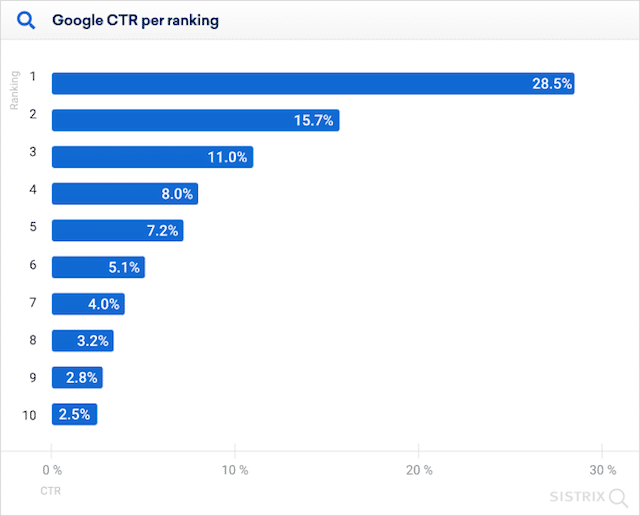
But by stealing the top spot (position 0) away from the first search listing, you increase clicks to your site by 8.6%.

So if you were ranking in position eight previous to winning a featured snippet, you would immediately gain an extra 5.4% of clicks just by moving up to the coveted position-zero spot – a 169% incremental improvement.
Not too shabby!
Earning that prized featured snippet position also lends itself to voice search, more on that next.
Harnessing the Power of Featured Snippets to Gain Extra Traffic Through Voice Search
Whether through smart home devices or mobile phones, the rise of voice assistants’ presents brands that have optimized for featured snippets with a massive advantage.
Google prioritizes answers for voice-based tasks, such as asking for a recipe or DIY instructions, from featured snippets.
And because voice search produces only one result (unlike desktop or mobile where you get ten or more results to choose from), locking down the featured snippet is incredibly important.
Right now, 47% of consumers use voice-enabled devices to perform an online search. Going forward (as that number continues to climb) competing for featured snippets becomes all that more crucial.
With the value of featured snippets now evident, let’s turn our attention to the type of featured snippets available in 2021.
SERP Features: Understanding What Is NOT a Featured Snippet
With so many SERP features being shown in the search results, featured snippets can get confused for other resource blocks like rich answers or knowledge graphs.
Before diving into the different types of featured snippets, you can rank for, let’s review some common SERP features that get misidentified as a featured snippet.
Knowledge Panel
Part of the Knowledge Graph, a Knowledge Panel is a special information box that provides a quick snapshot of information about entities like people, places, and organizations.

Unlike featured snippets, the content found in Knowledge Panels is automatically generated, pulled by Google from various sources online.
Google My Business, another type of information box is similar to a Knowledge Panel. But because the content found in the Google My Business panel is generated by the business that owns that profile, it is not considered a Knowledge Panel.
Knowledge Card
Like Knowledge Panels, Knowledge Cards sit under the umbrella of the Knowledge Graph.
They provide search users with high-level information, typically consisting of locations, dates, phone numbers, relevant facts, and related searches.
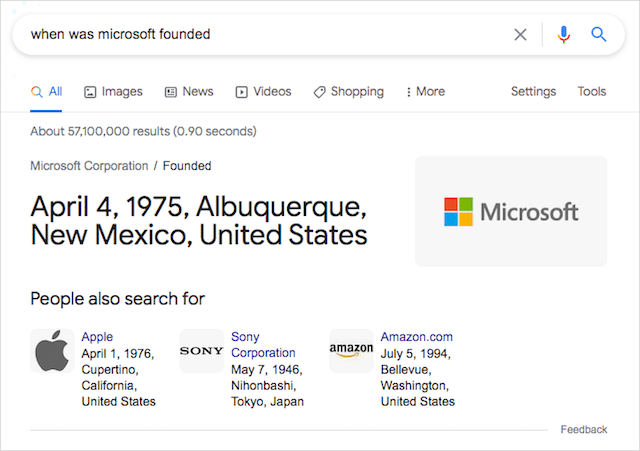
Knowledge cards typically don’t include a clickable search listing as the content provided is public domain information.
Entities Carousels
A list-like result, Google’s carousels display multiple cards of entities that belong within the same category though the information is pulled from various websites.
Here’s an example:
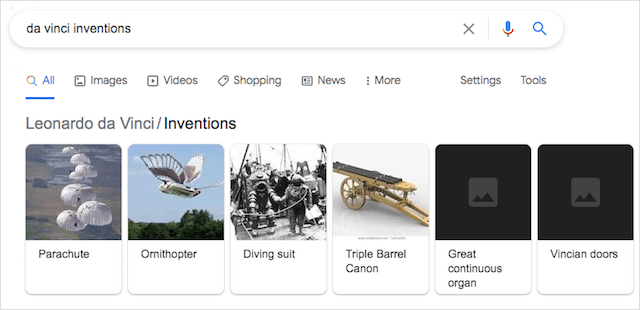
There also host carousels that display cards of information from the same website.
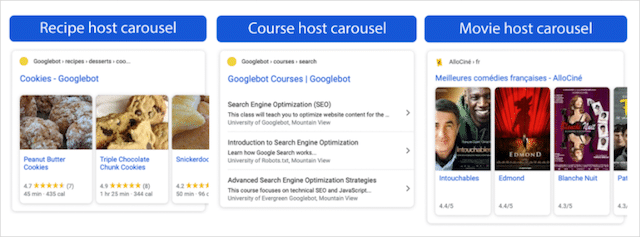
The typical information that appears in a host carousel includes recipes, movies, courses, and restaurants. Google compiles this information through the use of structured data.
Rich Answers
Formerly known as Quick Answers, Rich Answers provide users with quick, factual responses to their queries.
Rich answers typically cover numerical questions like “how big is the sun,” “when was [name] born,” or stock graphs.
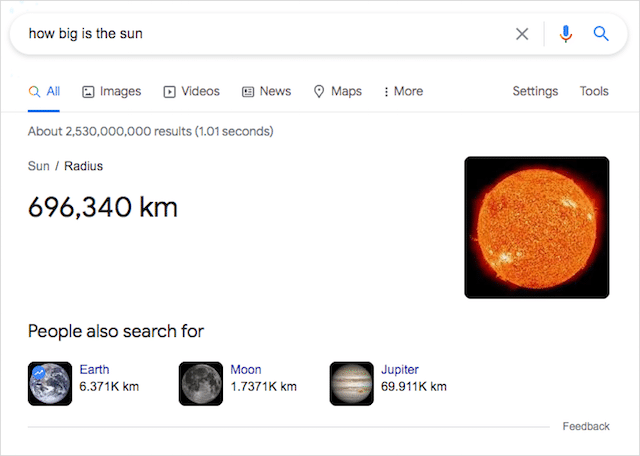
Because the information from rich answers typically comes from the public domain and sometimes comes from licensed data, Google rarely provides credit for these results.
Rich Snippets
Rich snippets and featured snippets – two sides of the same coin?
While both rich snippets and featured snippets display a large snippet of information, rich snippets differ from featured snippets in that they are an enhanced organic search result.
In other words, you can capture rich snippet opportunities in the SERPs by using structured data or schema markup, something that you can’t do with featured snippets.
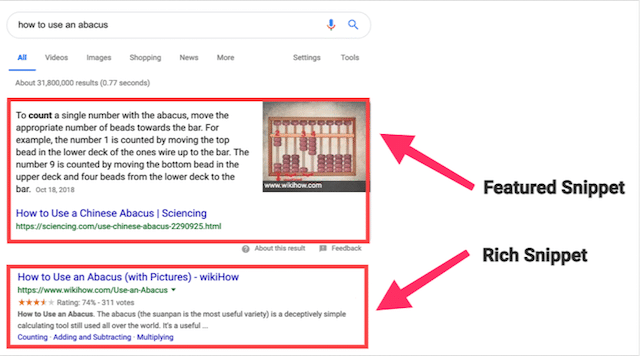
Another way to understand the difference between a rich snippet and a featured snippet is that a featured snippet will always appear above the organic search results (position zero).
In contrast, rich snippets can be displayed throughout the SERPs.
The 5 Types of Featured Snippets Out There
Now that we’ve clarified precisely what SERP features are NOT featured snippets.
Next, let’s move on to the different types of featured snippets out there.
(1). Paragraph Featured Snippets
The most common type of featured snippet out there is the paragraph snippet.
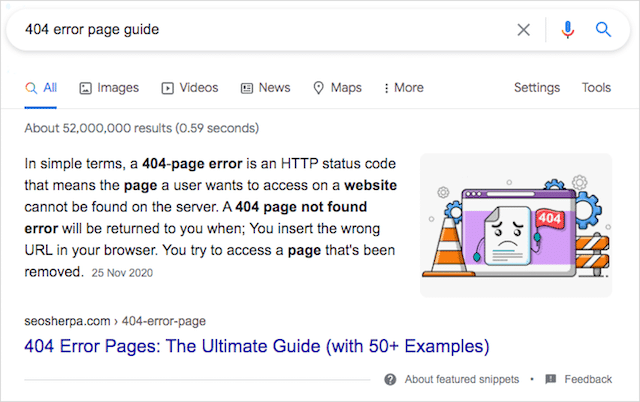
Paragraph snippets account for 50% of all featured snippets seen in Google search results.
As you can see from the example above, paragraph snippets’ goal is to answer the search user’s query directly from the SERP.
These types of featured snippets tend to display an image or an accordion of pictures from other sources.

Search Engine Journal points out that paragraph snippets are often displayed in the SERPs for question-based queries such as:
- How to do/get…
- Who is…
- What is…
- Why is…
- What is…
Like so:
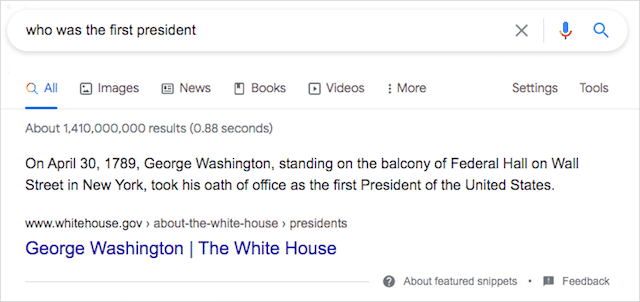
Paragraph featured snippets can sometimes be seen as harmful to a site’s organic CTRs as the search user typically does not require additional information from search listings.
In other words, when a paragraph snippet is displayed, the searcher may not need to visit the website, which is the source of the content.
(2). List Featured Snippets
Coming in at a second place, with 37% of all featured snippet results are list snippets.
This type of snippet can appear in the search results as a:
Bullet list
The information provided by a bullet point snippet is pulled from the page’s headings tags.
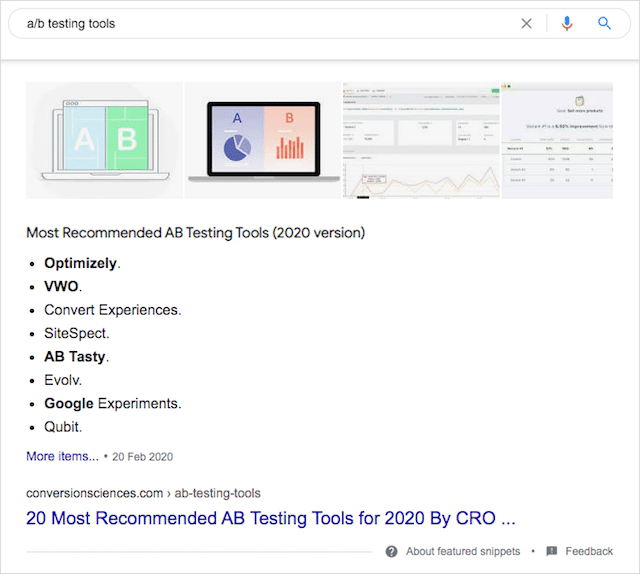
List snippets often appear for queries that involve:
- Best of…
- Benefits of…
- Feature lists
- Unranked items
- Ranked items
- Most popular…
Numbered list
When search users are looking for instructional steps, numbered lists are displayed in the search.
These ordered lists are displayed in a step-by-step format so readers can follow along with the process.
The typical search queries that display numbered list snippets include:
- DIY tasks
- Recipes
- How to…
- How do I…
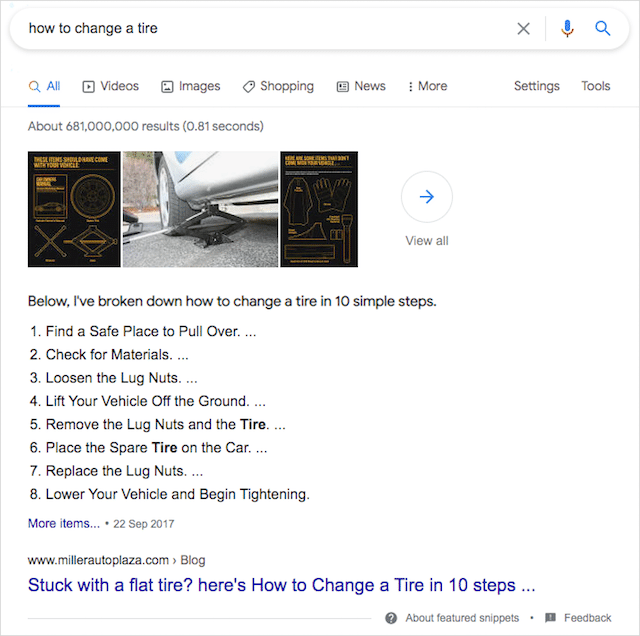
While list featured snippets go through a process step-by-step or highlight “best of…” content.
Search users are more likely to click through to the source website to read extra details or see accompanying visuals for the set of steps.
Unlike paragraph snippets, numbered lists are generally good to improve your site’s organic CTR.
(3). Table Featured Snippets
When collections of data are needed to resolve a search query, a table snippet appears.
Making up only 9% of all featured snippets, tables appear for queries which include:
- Lists
- Pricing
- Rates
- Data
Here’s an example of a table snippet
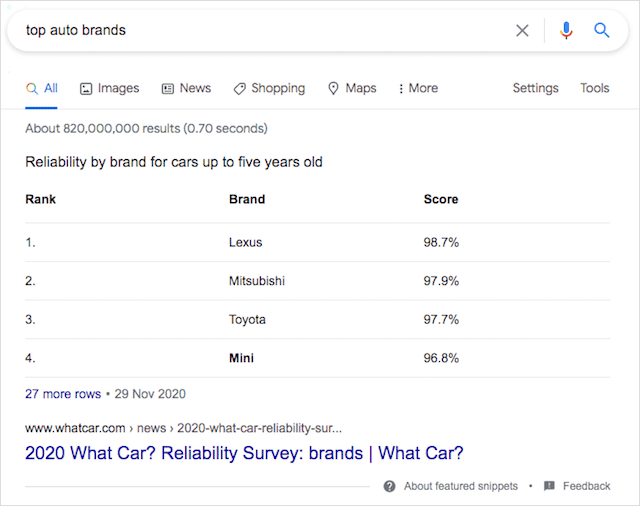
The unique thing about table snippets is that Google will reformat your page’s data or content to make it more suitable for search users.
While it’s helpful to provide an HTML table on your web page, Google is intelligent enough to decipher any rows and columns and translate the data into a table snippet.
(4). YouTube Video Featured Snippets
Websites are not the only source of information that Google will use to construct featured snippets.
YouTube videos can also show up in the search results as a featured snippet.
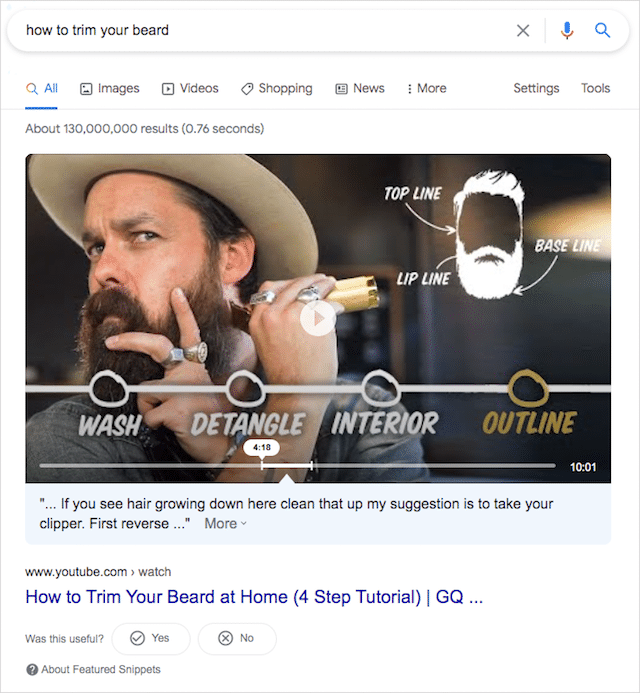
As shown by the example, most video snippets tend to show a specific clip within the video that best answers the search user’s query.
What’s more, any time a search query presents a featured snippet, Google may decide that showing a video merits the right response.
Table snippets are the only type of featured snippets that won’t display a video result as tables typically aren’t illustrated in a video format.
A video replacing another type of featured snippet is rare though as research done by Moz found that video snippets only account for 2% of all featured snippets.
(5). Accordion & Carousel Featured Snippets
Of the different types of featured snippets, accordion or carousel snippets are the rarest.
As Moz found out, so far, accordion-like snippets have rolled-out in the United States only. Non-U.S. markets fail to display the same search results as those in America.
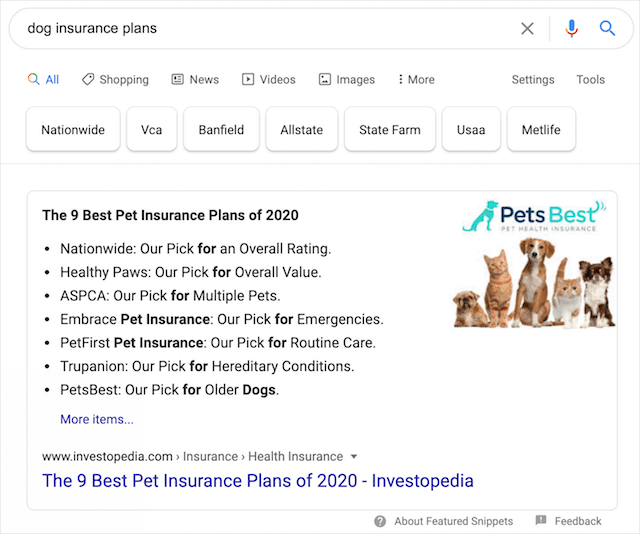
As the example above shows, these carousel snippets display related keywords to the search query.
Once a search user clicks on one of the carousel keywords, the featured snippet and the accompanying search results change to match the new search query.
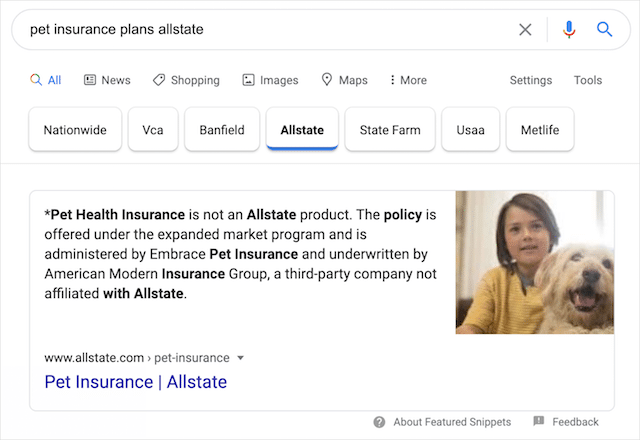
Now that you know which featured snippets are available to you, you’re probably curious how you go about getting securing featured snippets for your own content.
We’ll cover that next:
15 Strategies To Winning Featured Snippets
Despite there being no magic formula to winning featured snippets, there are several best practices (15 in fact) you can use today to improve your site’s chances of ranking for a featured snippet.
Here’s a quick summary of these featured snippet best practices:
- Know which featured snippets opportunities are out there
- Uncover more featured snippet opportunities with Google search
- Generate more content ideas with AnswerThePublic
- Target the right amount of keywords
- Long-tail keywords & featured snippet opportunities
- Use words that are likely to generate featured snippets
- Optimize content for specific featured snippets types
- Properly format your content for the right snippets
- Optimize your site’s FAQ section
- Don’t forget to fill your site with SEO-optimized images and video
- Make use of HTML5 semantic tags
- Use schema markup to present your content
- Maximize how you use subfolders
- Build up your brand authority
- Optimize on-page SEO elements
(1). Know Which Featured Snippets Opportunities Are Out There
When trying to compete for featured snippets, the essential first step is to find SERPs that already have a featured snippet.
Why?
Because it’s far less likely you’ll rank for a featured snippet when the keyword you target doesn’t ordinarily display one.
What’s more:
Knowing which search queries show a featured snippet will help you understand:
- What type of featured snippet is being offered
- How to optimize your content to match the search results
Don’t worry, I’m going to show you exactly how to optimize your content for a featured snippet later.
But first:
How to Find Featured Snippet Opportunities
There are two ways you can go about finding featured snippet opportunities.
The first is the go through your list of potential keywords and perform a Google search on each one.
Using a spreadsheet, you can note which keyword(s) has a featured snippet. Depending on how long your list of keywords is, this can be an arduous task.
The second (and more effective) way to find featured snippet opportunities is by using a tool like SEMrush or Ahrefs.
Ahrefs Keyword Explorer has a filter tool that allows you to filter out all other SERP features and zero-in on keywords that already have featured snippets in the search results.
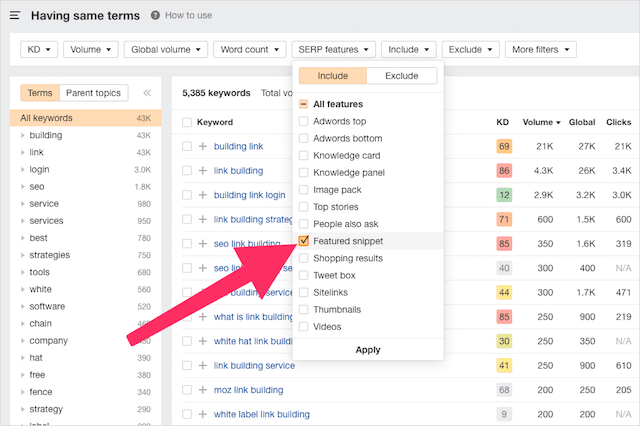
Alternatively, you can use Ahrefs Site Explorer to analyze the keywords you already rank for that display featured snippets.
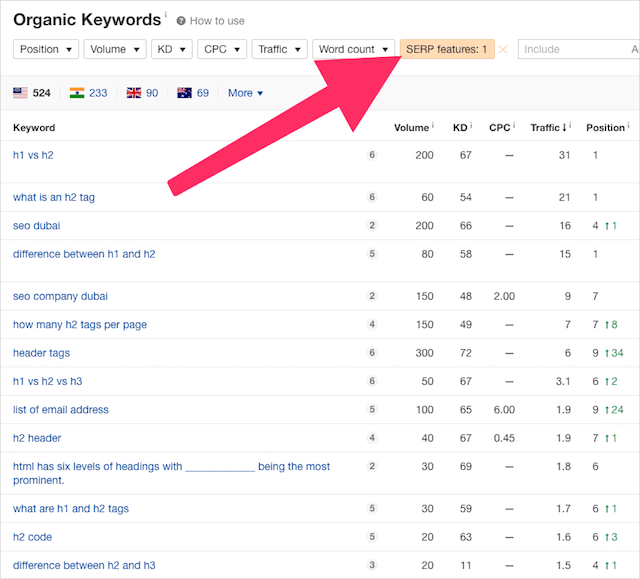
The image above shows a list of keywords our SEO agency ranks for, that we could optimize to appear in the covered featured snippet spot.
(2). Uncover More Featured Snippet Opportunities with Google Search
If your business or brand has a spartan budget for SEO tools like Ahrefs, you can also turn to Google to find more quick win opportunities.
Using Google’s search results, namely the “People also ask” section, you can put yourself in the shoes of your audience and try to optimize your content to reflect the answers that potential customers are searching for.
For example, if you owned an online computer store or ran a computer service business, one of the keywords you may have on your list is “install ram.”
A quick Google search shows that this query merits a YouTube snippet.
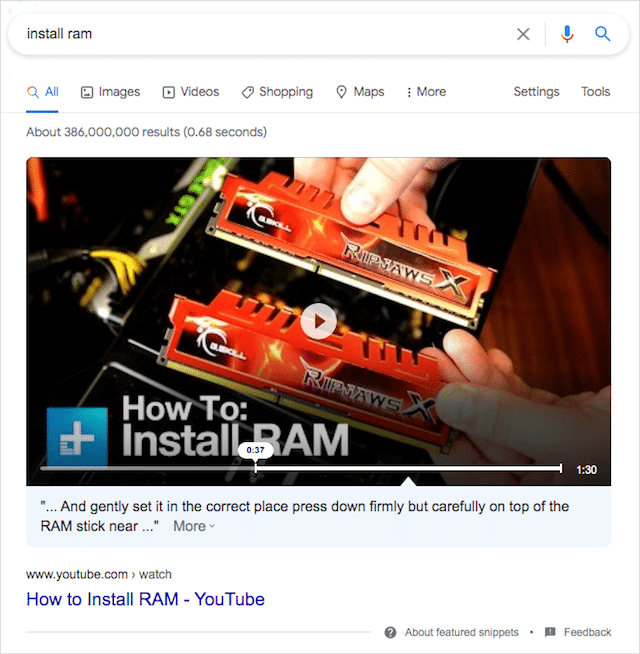
Scroll down further, and you will see the “People also ask” section. The questions in this section relate to the search query being performed.
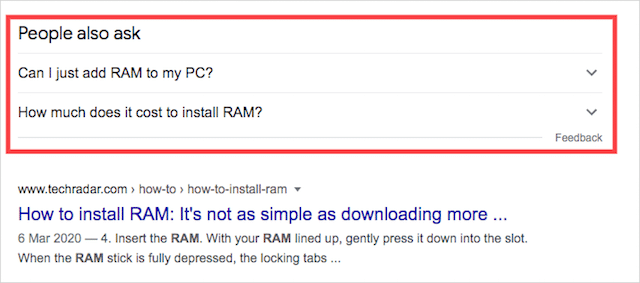
Click on some of these questions, and you’ll be directed to their specific search results.
One of the related questions “How much does it cost to install RAM?” also produces a featured snippet.
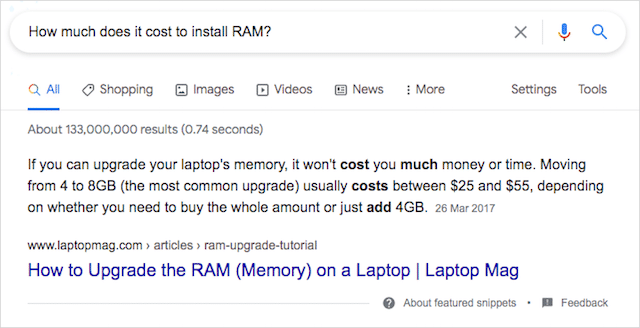
This is a quick and easy way to find new content ideas for your site or discover how you can leverage existing content to outperform competitors.
If you’d like to identify more questions than Google’s “People also ask” provides, then you’ll want to turn to a search listening tool.
And we have just the tools for you:
(3). Generate Featured Snippet Content Ideas with AnswerThePublic and AlsoAsked.com
AnswerThePublic is a content idea gold mine.
By inputting a seed phrase or keyword, AnswerThePublic will crank out a detailed list of questions that you can target in your content.

Using our “install ram” keyword as an example, let’s see the type of suggestions that AnswerThePublic comes up with:
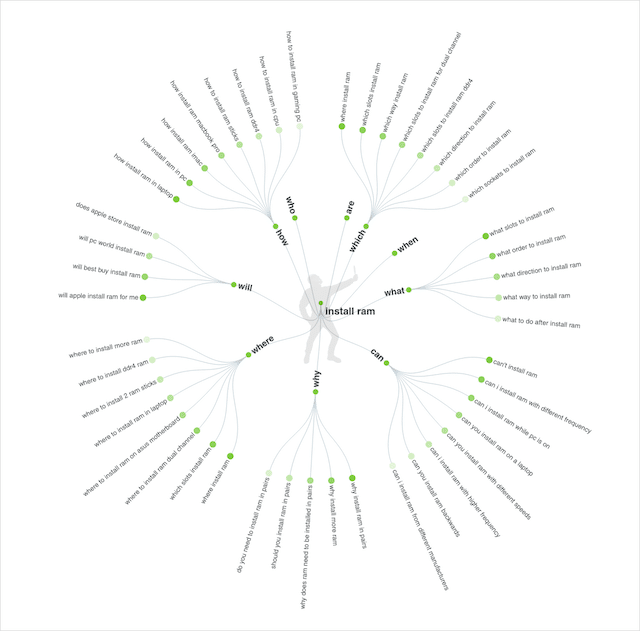
As you can see, some great questions that AnswerThePublic has generated include:
- What to know when installing RAM
- Which order to install RAM
- Should you install RAM in pairs
And since most featured snippets appear in question-based search queries, AnswerThePublic helps you effortlessly find featured snippet content ideas.
AnswerThePublic gathers data from Google’s Searches Related To feature.
You know the suggestions that display at the bottom of the SERP?
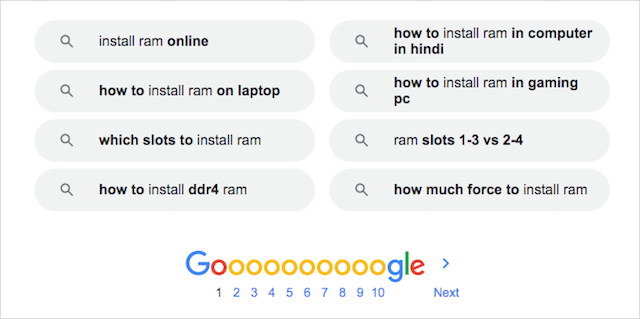
But, what about if you could quickly gather data from Google’s People Also Asked section?
Enter AlsoAsked.com:

Enter a search term into AlsoAsked.com and the tool will generate all the other questions related to that (and those related to them also).
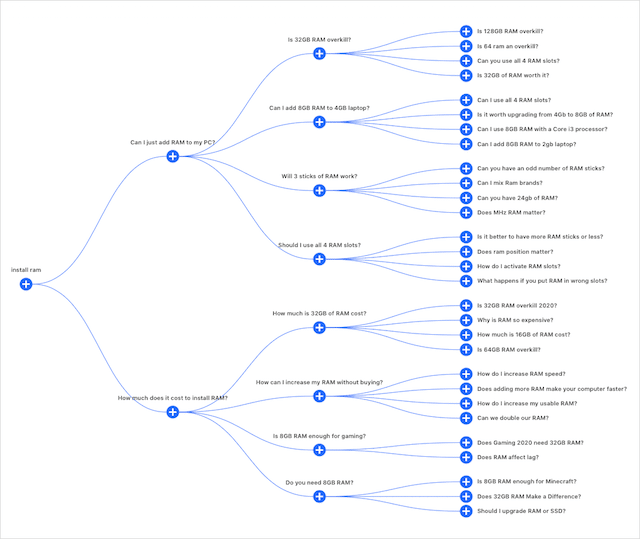
Using AlsoAsked.com provides a MUCH faster way to research the popular questions asked on Google, than the manual method I shared earlier.
Go ahead and give it a try!
Now you’ve identified a list of questions you can use in your content, let’s look at how you can put these content ideas to work.
(4). Target the Keyword length Sweet Spot to Increase Your Featured Snippet Chances
When it comes to triggering a featured snippet in the search results, how many words in a query most frequently result in a featured snippet displayed?
One?
Three?
Five?
Fortunately for you, SEMrush took out all of the guesswork.
In their featured snippet study, search queries made up of a single word only triggered a featured snippet 4.3% of the time. Three words in a query resulted in 11.87% of results have featured snippets. Five words? Only 16.96% of searches returned a featured snippet.
Search queries made up of 10 words triggered the highest number of featured snippets in the SERPs at 55.53%.
It’s clear that ten words are the sweet spot of search phrases as 11 words only had featured snippets appear 31.26%.
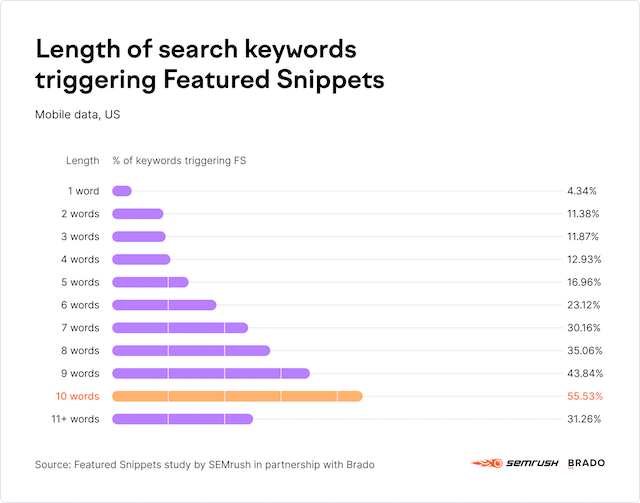
Of course, like our example “install ram” showed, shorter keywords still have the opportunity to earn a featured snippet. But as this data shows, the best luck you can give your site to win a featured snippet is by targeting longer search phrases such as question-based queries.
But earning featured snippets is just one reason why you should focus on longer keyword phrases.
(5). Mastering Long-Tail Keywords to Win Featured Snippet Opportunities
Including a long-tail keyword strategy in your featured snippet pursuit is a sure-fire way to increase website site traffic and produce a higher conversion value.
Let me explain.
Long-tail keywords contain three words or more and are incredibly focused.
It’s called “long-tail” not because it has a longer word count. “Long-tail” is a statistical concept that describes the long-tail end of the search demand curve.
While short-tail (or head term) keywords like “running shoes” have the highest search volume, most searches are actually long-tail keywords.

This is why having a long-tail keyword strategy is essential to earning featured snippets.
Search queries with 10 words cause featured snippets to appear 55.53% of the time in search. By targeting long-tail keywords your brand is able to get its content to appear in the 55.53 percentile of search results.
But long-tail keywords provide several other benefits, namely, search intent and higher conversions.
Let me show you an example.
Consider the search term “running shoes.” “Running shoes” would be considered a short tail keyword.

Broad search terms like “running shoes” are less intent-driven, resulting in lower conversions.
More importantly, such a generic search term would be challenging to rank for as you would be competing with huge brands who have greater authority in search and more significant budgets for SEO services.
Whereas a specific phrase like “best running shoes for flat feet” is highly intent-driven. It’s safe to assume that when a search includes the term “best running shoes for flat feet” the potential customer has a clear intent to purchase.

Long-tail keywords also help you create more targeted content that can rank easily in search.
By expanding the broad search term “running shoes” into long-tail keywords like “running shoes for bad knees,” “best long-distance running shoes,” or “best running shoes for women,” will make for highly effective SEO content that can rank for multiple featured snippet terms.
And with voice search continuing to trend upwards, having a long-tail keyword strategy in place allows you to target voice SEO opportunities.
But simply targeting long-tail keywords isn’t enough to land a featured snippet.
To further your chances with featured snippets, you need to know some common word themes that Google loves to use when generating featured snippets.
(6). Use These Featured Snippet Power Words and Skyrocket Your Ranking Chances
Question-based search queries may result in featured snippets appearing in the SERPs.
But do you know which query modifiers return the most snippets?
We’ll cover that next:
A study done by STAT Search Analytics found that query themes like financial queries, time queries, health queries, DIY processes, and general questions and definitions frequently triggered a featured snippet.
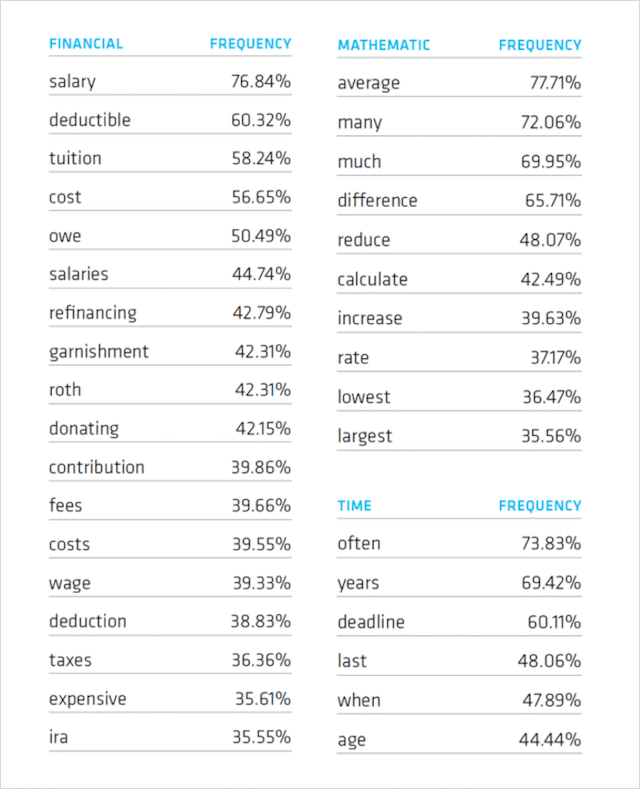
And some individual words worked like magic dust in making featured snippets appear:
- Forming – 75%
- Does – 69.4%
- Become – 63.46%
- Cause – 61.57%
- Qualify – 60.93%
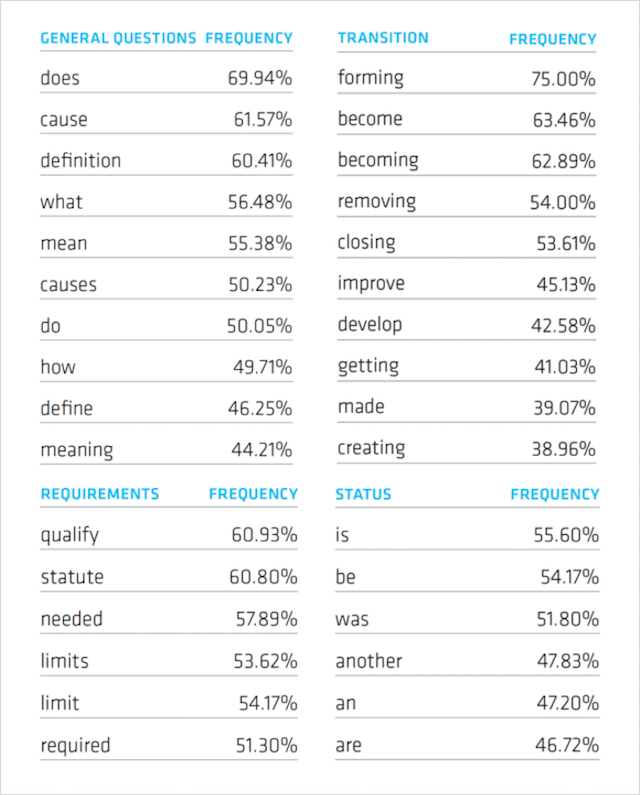
Interestingly enough, local queries that included a geo-modifier (e.g., “restaurants new york”) rarely produced a snippet.
Additionally, local business terms saw snippets less than two percent of the time.
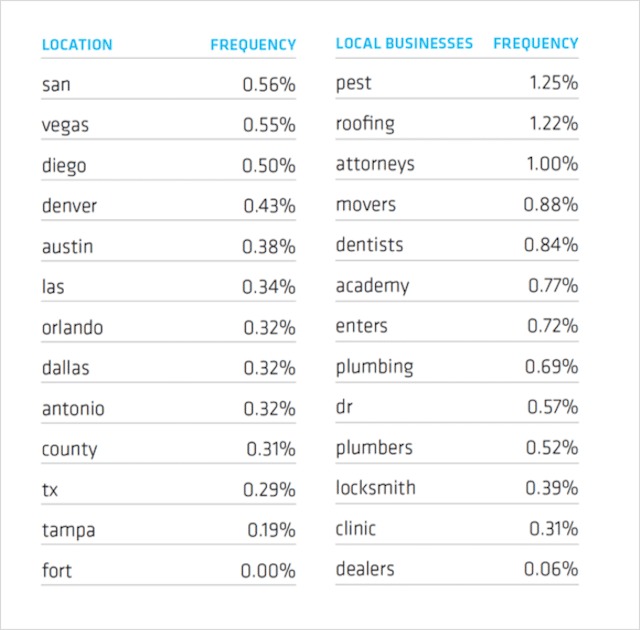
Local search isn’t the only category that has a low occurrence of featured snippets. Shopping queries, image and video queries, info/help queries, and factual queries (articles, news, Wikipedia, etc.) also have meager snippet occurrence rates.
This study reveals that to maximize featured snippet opportunities, long-tail keywords should include specific power words:

Plus, if your lucky and your niche is DIY, health, financial, or general interest, your chances of appearing in a featured snippet increase even more.
Now that you know how to find content opportunities with a high chance of ranking for featured snippets let’s optimize this content for the different featured snippets types available.
(7). How to Optimize for Google’s Featured Snippet Box (3 Powerful Tips)
As we already covered in tips #1 and #2, there are multiple featured snippet types you can optimize for.
If the search term you’re competing for already displays a paragraph snippet, you know you need to format your content to match the snippet type.
Likewise, if a list-based snippet appears, structure your content with numbered lists or bullet points.
Here are three easy steps to follow to increase the probability of your content appearing in featured snippets.
Focus on question-based queries
As we know from the SEMrush study on keyword length and featured snippets, most featured snippets, particularly paragraph snippets, are triggered by question-based search terms.
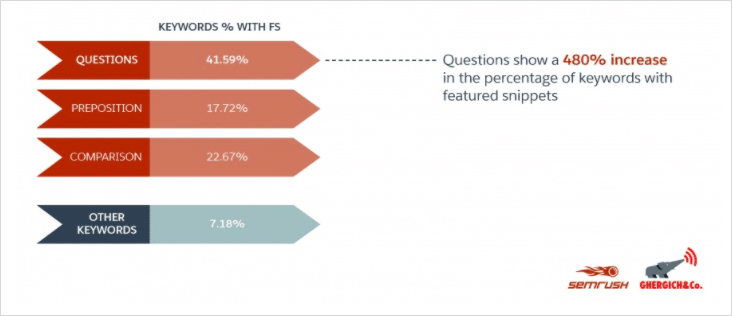
In another study done by Ghergich & Co., it was found that questions containing “how” and “have” increased the likelihood of triggering a list-type snippet by 46.91% and 17.71% respectively.
Questions containing the word “which” earn the most table-type snippets at 16.20%.
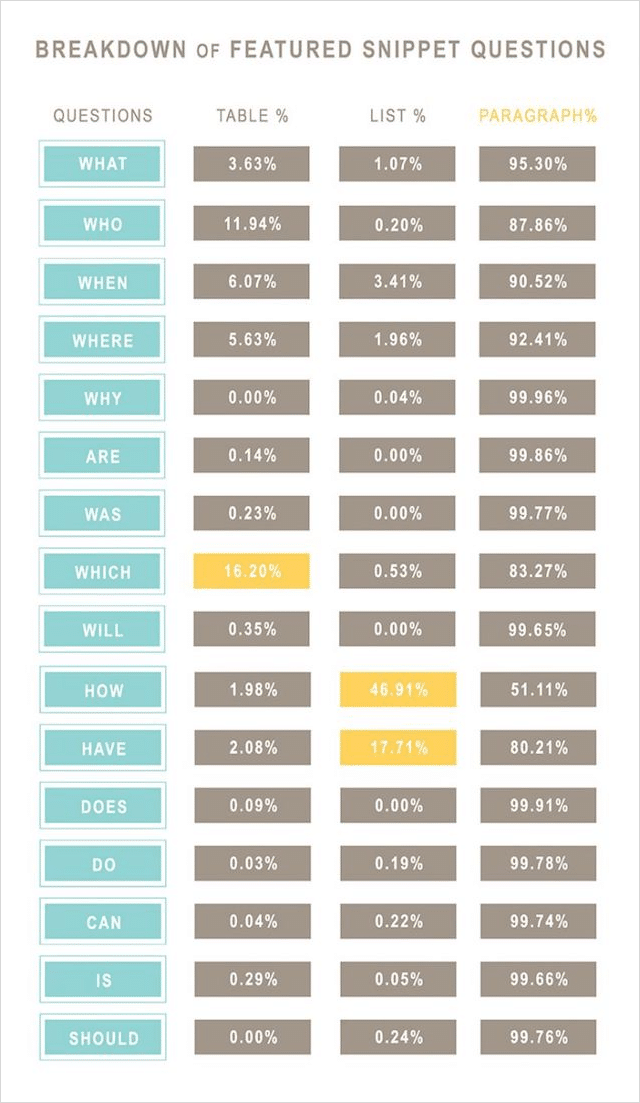
So, in summary, answering which, how, and have questions will increase your chances of featured snippet success.
Write with the inverted pyramid in mind
With dwell time being a critical ranking factor, many content marketers hesitate to give answers right away.
They fear that website visitors will leave the site in a few seconds by providing an immediate solution to the search query.
But when it comes to featured snippets, that’s precisely what you have to do.
As you can see from the image below, by repurposing the inverted pyramid writing style for SEO, you lead with the answer and then discuss context.

By telling search users immediately what they want to know, you increase the likelihood of winning that coveted position zero.
And since Google prefers long-form content, typically ranking it over short-form content, you should structure your content by:
- Writing a descriptive subheader that asks the question
- Adding a one-paragraph succinct response that answers the question at the top of the page
- Divulging more details and data
- Using the rest of the article to elaborate further on your answer
To increase engagement, add a tl;dr (too long, didn’t read) summary to articles like list posts or how-to guides.
This sets expectations for your content, creating a positive user experience that provides positive engagement signals to Google.
Aim for the optimal featured snippet length
To further improve your chances of winning a featured snippet, you should also provide a clear answer to the search query within a certain word count.
Moz has also found that the optimal length for a paragraph snippet is 45-97 words. SEMrush also analyzed paragraph snippets and found the optimal length to be 40-50 words.
My recommendation?
Shoot for a word count of 40-60 words.
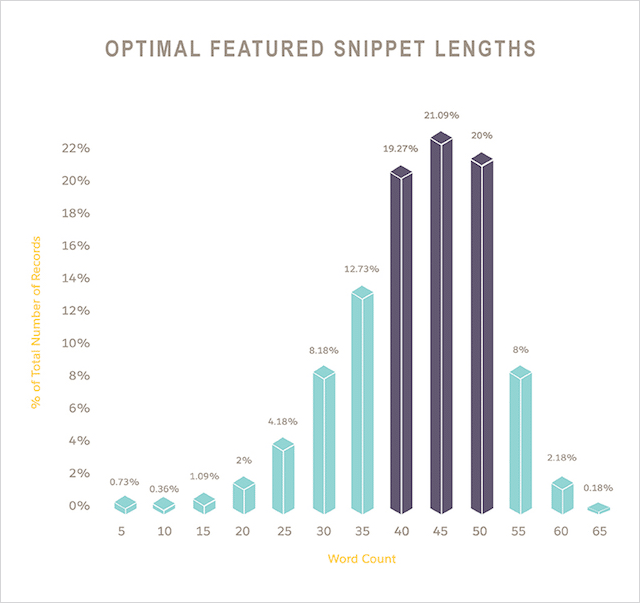
When it comes to list snippets, aim to create a list that is longer than seven or eight items.
Why?
Google typically has an eight-item maximum before truncating the list and displaying a “More items…” link.
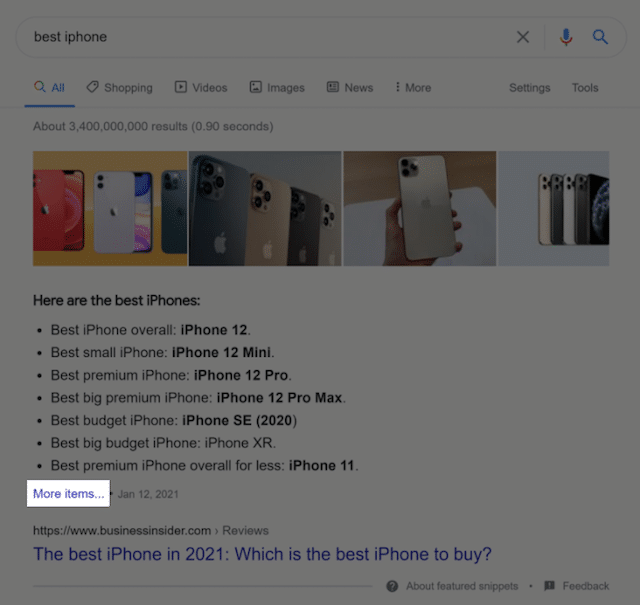
The “More items…” text on the list snippet is vital because it encourages the search user to click onto your site, rather than remain on the SERP.
And, we all know that more traffic = more conversion potential.
For table snippets, the maximum number of rows and columns displayed by Google is nine and three, respectively.
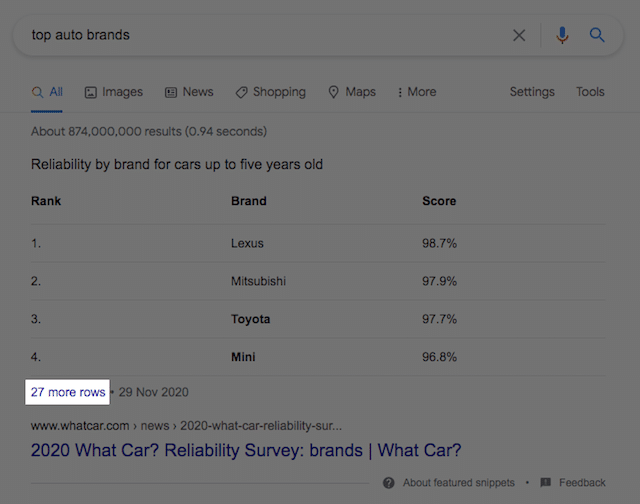
Like list snippets, Google encourages search users to visit the site featured in the snippet by showing a “more rows” text.
As for formatting your content for snippets, we’ll be covering that in the next section.
(8). How to Format Your Content Right for Featured Snippets
You already know that featured snippets are displayed as either a paragraph, list, table, or video.
But, what I haven’t shared is exactly how to format your content “right” for each one of these featured snippet types, so let’s break each one down.
How to Format Your Content for Paragraph Featured Snippets
As I already shared, to get shown as a paragraph featured snippet you should layout your content as a 40-60 word paragraph-style answer to a question which you should wrap in a header tag.

We use this simple technique on the SEO Sherpa blog – and it works a treat!
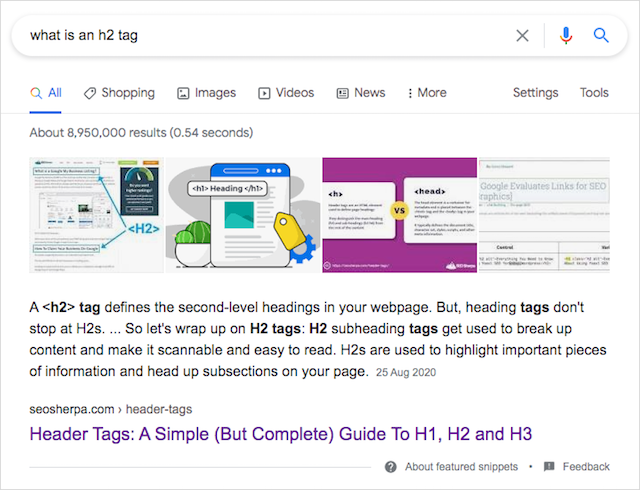
Just remember to present the search query you are targeting (or a similar question) as a subheading <h2> and provide your succinct answer below.
Your response should be displayed with a paragraph <p> markup.
But what about list or table-style snippets? That’s next:
How to Format Your Content for List and Table Featured Snippets
To compete for list featured snippets, you also need to make use of the right HTML tags.
A numbered list snippet should be served with an “ordered list” <ol> HTML tag.
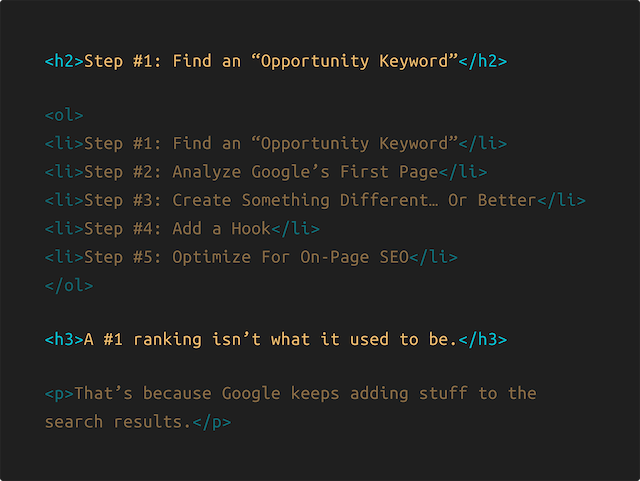
On the other hand, a bulleted list snippet should have an “unordered list” <ul> HTML tag.
To help Google better understand the content of your list, you should also use subheadings (<h2> and <h3>) tags for the items in your list.
Another best practice is to include this list at the top of your article as a summary type. Just like HubSpot do here:
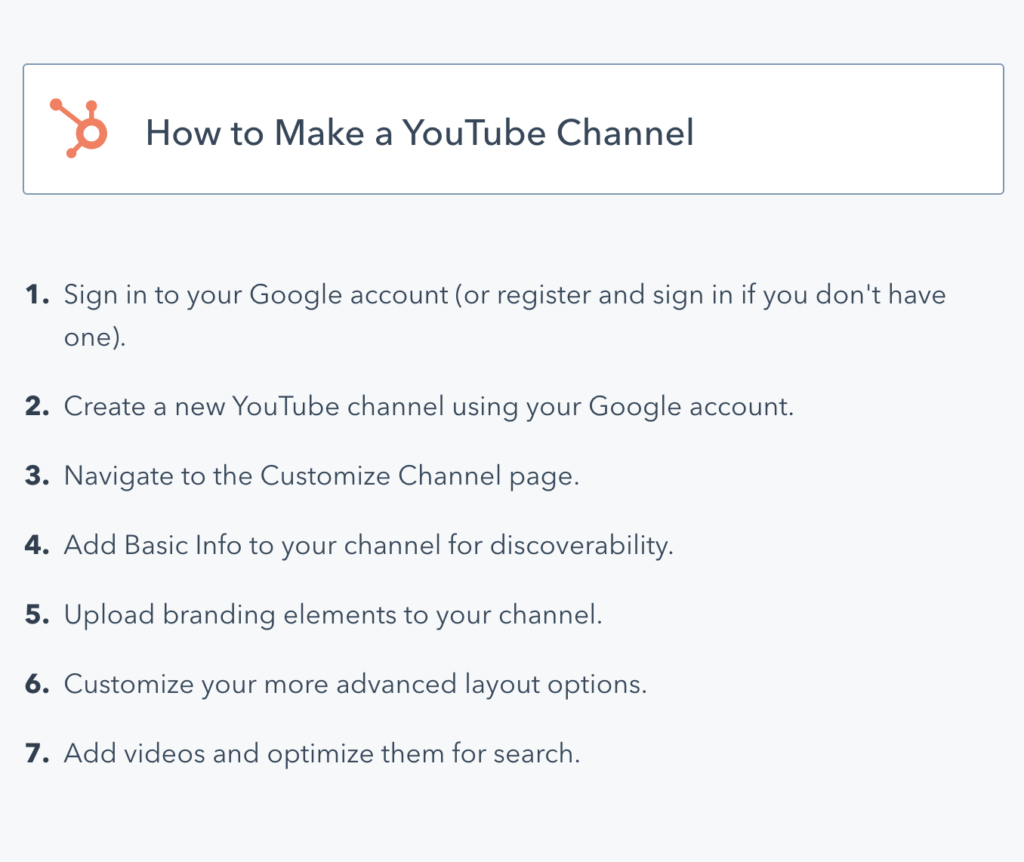
Use the rest of the article to break down each step or item in your list.
When targeting table featured snippets, format your answers to the search query with a table <table> HTML tag.
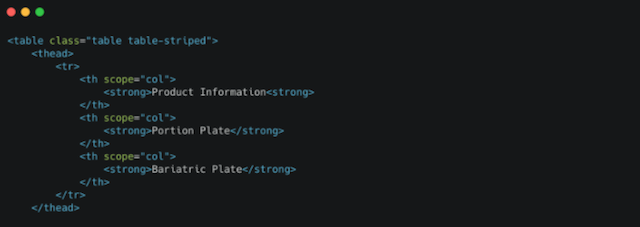
Be sure to build the table correctly in HTML rather than CSS.
CSS tables are not read by Google, even if they look like a table.
John Mueller has also gone on record to say that having a clear content structure with the appropriate HTML tags helps Google easily extract the content for a featured snippet opportunity.
How to Format Your Videos for YouTube Video Featured Snippets
To get your YouTube content to appear for video featured snippets, format your videos using the traditional content practices for other featured snippet types.
Hubspot has found that 80% of all video featured snippets that appear in the SERPs have the exact keyword in their video name.
PRO TIP: You should go back and update old YouTube videos to earn the opportunity to win a featured snippet.
Aiming to make your content as accessible as possible can also help to trigger a featured snippet.
This means having a search-optimized voiceover in your video, uploading a video transcript, writing up a detailed video description formatted for other featured snippet types (i.e. lists), and is keyword-optimized.
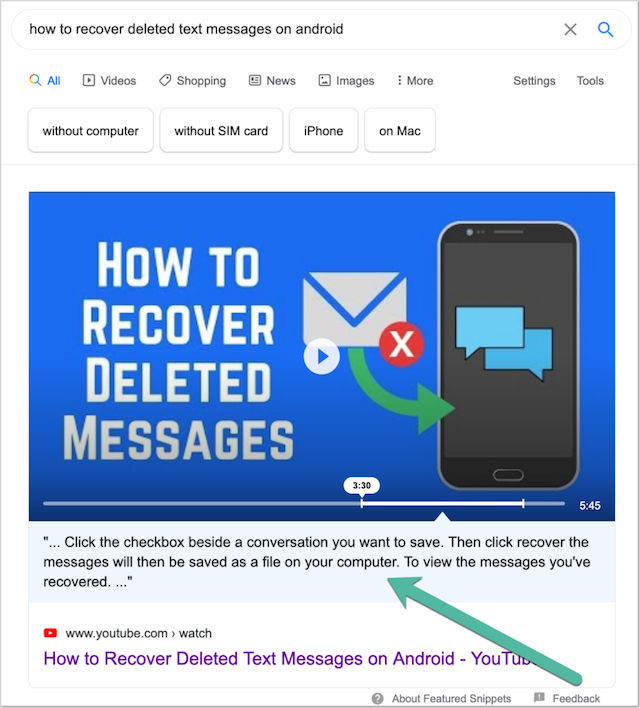
These formatting tips should help you better structure your content to get shown in each of the four featured snippet types.
But there’s another section of your website that can also be structured to provide featured snippet wins.
(9). Optimize the FAQ Section of Your for Featured Snippets
If you have yet to make FAQs a priority on your website, there’s no better time than now to do so.
In today’s age of answer boxes and zero-click searches, a well-optimized FAQ page helps you better serve your customers – from with the SEPs themselves.
An FAQ page can act as a catch-all for your brand, providing all of its most often requested information on a single web page.
A well-structured FAQ page, that’s keyword-optimized, helps search users make an educated decision in response to their search query.
Something that Google loves to reward.
FAQ content can rank well for high-intent search phrases that contain words like “compare,” “what is,” and other relevant keywords. Typically, this type of content drives extremely targeted traffic to your site.
And when included with the right type of call to action, can result in prospective customers quickly moving through your sales funnel.

In addition to these SEO benefits, a well-structured FAQ page can also increase your chances of landing a featured snippet.
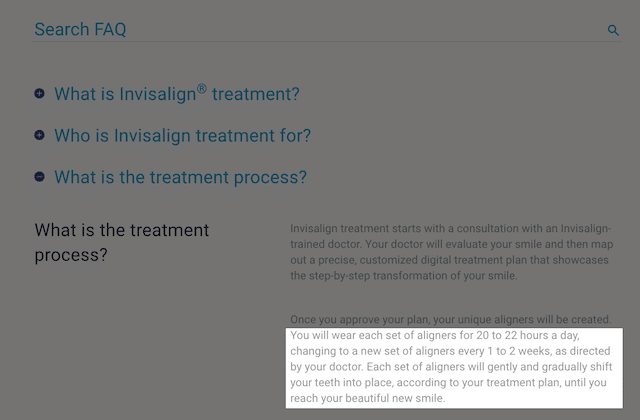
Because you can pose several long-tail search queries as questions on your FAQ page, the higher the chance you’ll see your site appear as a featured snippet.
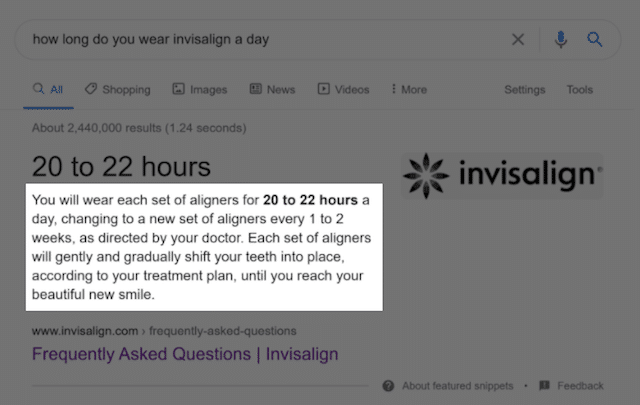
Be sure to wrap the targeted search queries with <h2> tags and respond with concise answers to get featured.
You can also add structured data to your FAQ page to help it rank as a rich snippet in the SERPs.
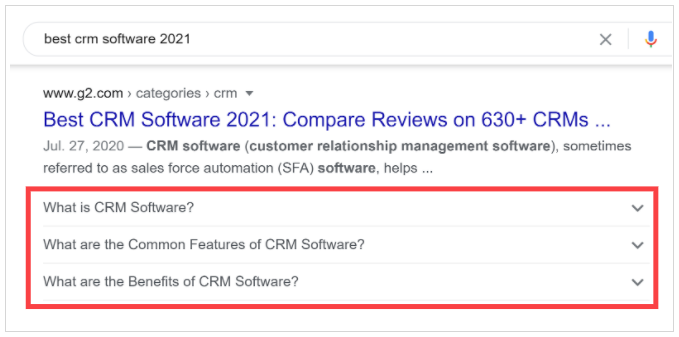
Though it should be noted, there is no guarantee that Google will display your listing as a rich result or as a featured snippet (we cover this in more detail below).
Now that we’ve covered how to format your content for featured snippets properly let’s look at what images and videos can do to your featured snippet chances.
(10). Pack Your Content with SEO-Optimized Images
Most featured snippets (except video snippets) will display an image in the answer box.
But here’s the thing:
The images displayed in the featured snippet don’t necessarily come from the same website as the snippet content.
Google uses its image algorithm to determine which images are best served with the featured snippet being shown.
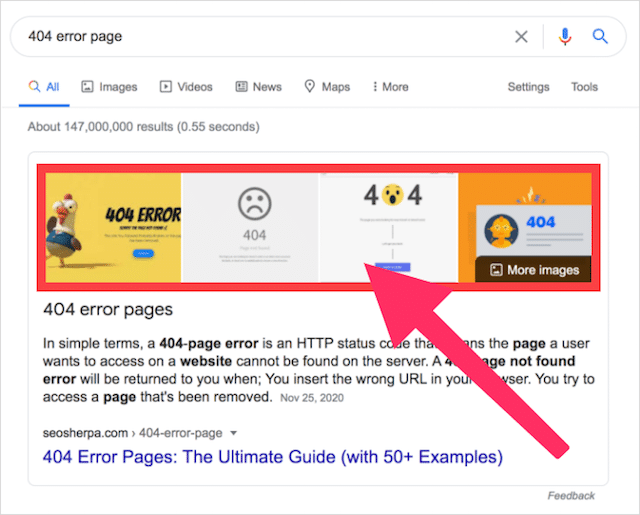
As you can see from the image above, despite our 404 Error Page blog post being displayed as the featured snippet, Google chose to display a carousel of images not from our post – as it felt like they best resolved the search query.
Many of the images displayed in the snippet carousel came from the top-ranking results in Google’s Image Search:
Because there’s no way to determine how Google’s image algorithm works, focus on the following image optimization tips:
- Perform image keyword research
- Create standout images for E-A-T and CTR
- Choose the right file type for your images
- Scale images to optimum proportions
- Optimize your file names
- Reduce images’ file size
- Write descriptive alt text with your keyword
Our in-depth Image SEO guide covers these strategies and more in greater detail so you can start ranking better in Google Image Search.
But, that’s not all you should do…
I recommend you crop your images to optimum featured snippet format.
The average graphic in a featured snippet is 159 pixels tall and 197 pixels wide.
This means, if you keep the same proportions, and scale your images up to 960px (h) x 1200px (w) you’ll increase your chances of your images getting shown.

With all of these featured snippet tips and strategies at your fingertips, you may be ready to nail that super-precious position zero.
But, these techniques are also the same ones that your savviest competitors are using to make the most of their featured snippet opportunities.
So, if you’re ready to gain that decisive advantage over the competition, read on as I highlight five rarely-used techniques you can use today to get that featured snippet you rightly deserve.
(11). Make use of HTML5 Semantic Tags
As you know, HTML tags like subheaders <h2> and ordered lists <ol> increase your chances of ranking in featured snippets.
These HTML tags, though are only used to define the content’s appearance on the page.
Semantic HTML5 takes the content optimization process a step further by explicitly defining the content’s meaning within their specified HTML elements.
This extra level of clarity helps search engine crawlers better prioritize (snd serve) your page’s content within SERPs.

By using semantic HTML5 tags, you provide search engines with additional information that allows them to read the page faster and determine the significance and context of the main content.
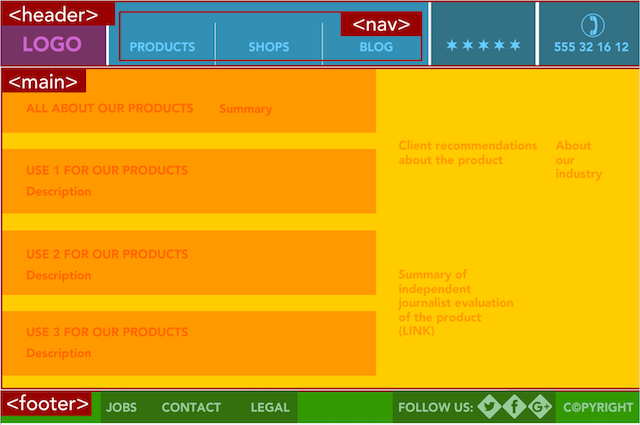
Using the <article> tag provides a content hierarchy that Google can use to isolate, prioritize, and extract the page’s main content. This simple semantic HTML5 implementation makes machines like Googlebot and Bingbot happy, which results in ranking improvements.
To go a step further, you can also add multiple <section> tags within the <article> tag. By adding these distinct parts within your main content, you can boost your chances of winning several featured snippets from one piece of content.
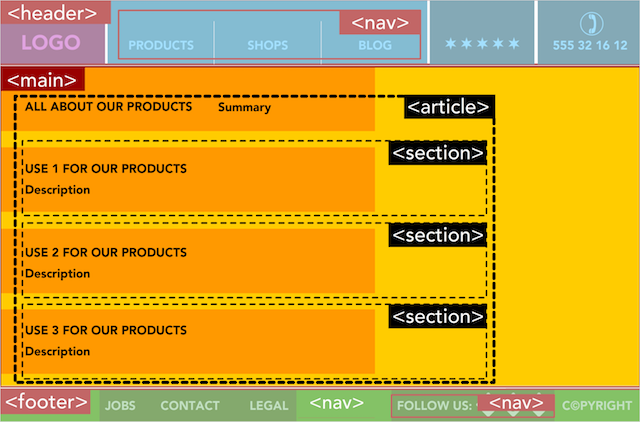
Be sure to use the <aside> tag for less important content like sidebars, so you emphasize the page’s main article as seen in the example above.
Knowing how to use HTML elements like <article>, <section>, and <aside> will go a long way in making sure your content is readily accessible by Google’s (and Bing’s) bots.
This HTML knowledge will also come in handy with the next strategy.
(12). Use Schema Markup to Ready Your Content For Featured Snippets
When it comes to schema markup and featured snippets, there tends to be conflicting advice.
But, let’s not get into a debate about to structure or not to structure, let’s just hear what Google has to say on the matter.
Here’s what Gary Illyes had to say in 2020 about featured snippets and structured data.

In this quote, Gary was discussing Rakuten and their use of Google’s recipe structured data. By enhancing their search listing with schema markup, Rakuten increased its site traffic by 2.7x and average session duration by 1.5x.
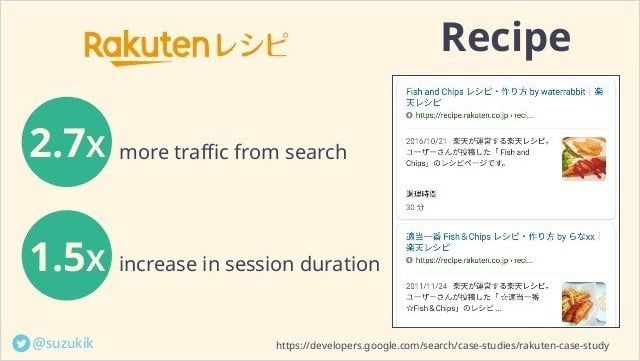
John Mueller has also highlighted the benefit of structured data, stating that “things like structured data markup” helps Google better “recognize the content properly.”
By using specific schema markups, Google can natively understand the main content within a web page. And like semantic HTML5, you get rewarded when you make it easier for Googlebot to understand the page’s content.
So which schema markups should you focus on when trying to rank for featured snippets?
Here are the ones you should prioritize:
- Article
- Q&A
- ItemList
- HowTo
- FAQ
Note: Head over to our Rich Snippets guide to learn why you should leverage the power of structured data (even if you’re not competing for featured snippets) and to grab our non-developers guide to creating structured data code.
(13). Leverage the Power of Subfolders to Drive More Featured Snippet Results
When it comes to SEO and rankings, which is better for your site, subdomains, or subfolders?
According to Google, both are treated equally. And while that may be true in theory, subfolders are the way to go when it comes to featured snippets.
And here’s an added benefit to using subfolders, because subdomains are seen as separate websites by Google, your brand’s link equity gets divided.

This is not the case with subfolders.

So what is the optimal number of subfolders you should use to get a featured snippet?
We recommended you stick with a maximum of three subfolders.
SEMrush’s research agrees with that sentiment:
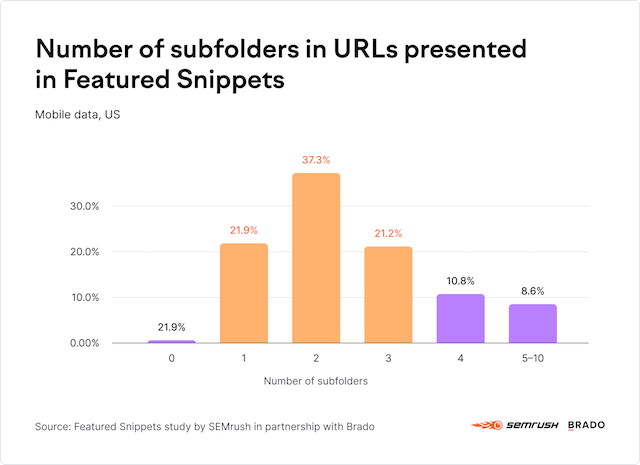
But why a maximum of three subfolders?
When you have multiple subfolders, the page moves further from the root of the domain.
When this occurs, Google assumes the page to be less important – and is unlikely to rank it.
To know more about subfolders and URL optimization, we’ve written a step-by-step guide on creating SEO-friendly URLs.
(14). Build up Your Brand Authority – It’s ESSENTIAL to Ranking in Featured Snippets
Unlike the other tactics previously mentioned in this article, this strategy cannot be implemented as easily.
Brand authority is a central pillar to outperforming your competitors in position zero.
Because 99.58% of all featured snippets are pulled from search listings that already rank in the top 10 positions, you need to be a brand that is seen as trustworthy and, most importantly, authoritative.
So what do you need to do to build this authority? You need to bolster your site’s authority signals:
- Strong backlinks
- E-A-T (Expertise, Authority, Trustworthiness)
- Searchable content
- Consistent, quality content marketing
- Social media marketing
- Quality guest blogging
- Thought leadership
- Online reviews
- Local Citations & NAP (Name, Address, Phone number)
It’s important to remember that there’s no shortcut to building long-lasting brand authority. It’s a long-haul job that requires time and resources.
But by focusing on the critical authority signals above, you’ll soon establish that authoritative online presence that potentially leads to featured snippets.
(15). Optimize Your On-page SEO For Featured Snippet Success
The final strategy we’ll be covering to help you win that coveted featured snippet position is SEO best practice.
By optimizing your page’s six key content areas with on-page SEO, you maximize their ranking signals, leading to improved visibility in organic search results.
These six on-page elements are:
- Title Tags
- Meta Description
- Header Tags
- Page Content
- Page URLs
- Internal linking
Here’s a quick rundown of how you can optimize these on-page elements.
But when it comes to Featured Snippets, why is On-Page SEO important?
Because, to rank as a featured snippet, you must first rank on the front page of Google.
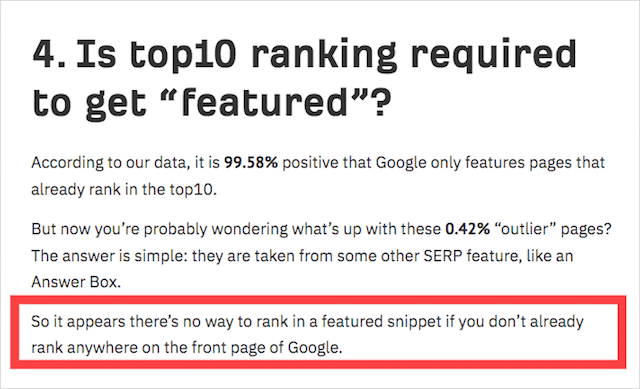
And, to rank on the first page, you need rock-solid on-page SEO such as having your target keyword contained in your title tag:
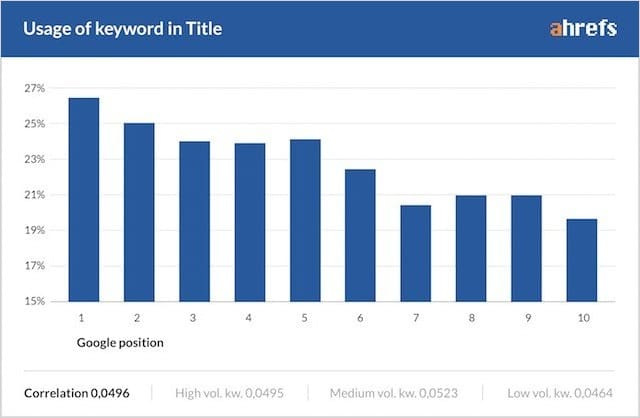
Mastering on-page SEO can also contribute to your brand authority efforts, helping you develop an online presence capable of ranking in the top 10 results.
Is Your Site Optimized for Featured Snippets?
Ranking for featured snippets, like any other Google SERP feature, doesn’t happen by chance.
With everyone competing to get noticed on the front page of search results, standing out requires a complex mix of SEO strategies, content optimization know-how, and some technical understanding.
It can be a challenge to reach that prominent featured snippet position. Still, by leveraging the strategies and tools mentioned above, you’ll be able to land your content on that oh-so coveted position zero.
And to help you with that, I’ve included a handy cheat sheet to get your content ranking for featured snippets.
You can download the FREE bonus below:




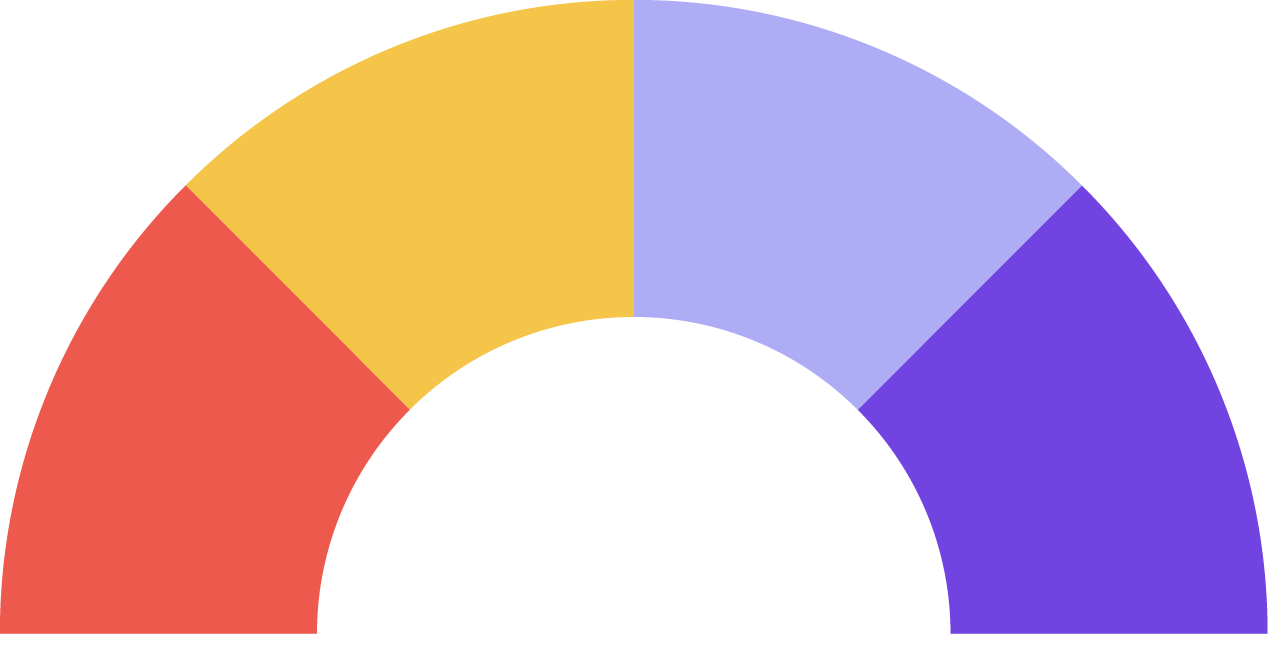







Leave a Reply